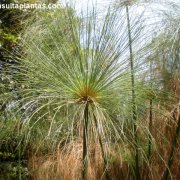Care of the aquatic plant Cyperus papyrus or Paper reed |
|
The genus Cyperus, family Cyperaceae, includes 700 species of annual and perennial plants distributed on all continents. Some species are: Cyperus papyrus, Cyperus haspan, Cyperus alternifolius, Cyperus gracilis, Cyperus longus, Cyperus diffusus, Cyperus esculentus. Common names: Papyrus sedge, Nile grass, Indian matting plant, Paper reed. This species is native to Africa. They are rhizomatous and aquatic plants with triangular section stems that reach 5 meters (16,4 feet) in height. The leaves appear in tufts at the end of the stems and are long, thin and jade green. The flowers appear in brown spikes that are not as decorative as the foliage. These easy-to-grow plants are used in ponds or small lakes; its extension should be controlled from the rhizomes so that it does not become invasive. Papyrus sedge is also used in pots as indoor plant. Cyperus papyrus can grow in full sun or semi-shade outdoor exposures; indoors it is better to place them in an illuminated exhibition but without direct sun. The winter safety temperature is 10 ºC (50 ºF). The soil can be a mixture of 25% coarse sand, 25% garden substrate and 50% peat. If Paper reed is grown in pots, it must be watered frequently so that the substrate is always moist. Nile grass does not resist drought. Indian matting plant appreciates a monthly fertilization with mineral fertilizer in spring and summer. Prune intensively at the end of winter to make them sprout more vigorously. Cyperus papyrus is a plant resistant to the usual pests and diseases. Papyrus sedge propagates easily by division of rhizomes or by cuttings of 15 cm (5.9") in length that are put to root in water and then transplant into a pot. |
Images of the aquatic plant Cyperus papyrus or Paper reed |
Find plants
Cyperus papyrus or Paper reed | Care and Growing
© 2025 FavThemes



